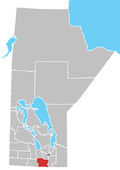Plum Coulee
Plum Coulee is an unincorporated urban community in the Municipality of Rhineland within the Canadian province of Manitoba that held town status prior to January 1, 2015.[1] It is west of Altona, one hour southwest of Winnipeg and 14 miles from the United States border. It is also the former home to the Plum Coulee Xpress hockey club. It has a man-made beach located in town called Sunset Beach.[2]

Development
Plum Coulee's population of 904 is growing through land development.[3] Working with local land owners, the former Town of Plum Coulee developed a long range zoning plan that can accommodate new industrial partners, commercial ventures, and private residents.
Notable persons
- Philanthropist Saidye Bronfman was born in Plum Coulee.
- Violinist Rosemary Siemens is from the Plum Coulee area.
- Food writer Cecily Brownstone was born in Plum Coulee.
Climate
Plum Coulee has the hottest daytime temperatures in Manitoba. Summers are hot and winters are similar to other cities in the Canadian Prairies. There are 21 inches of precipitation annually.
| Climate data for Plum Coulee, MB (1971-2000 Normals) | |||||||||||||
|---|---|---|---|---|---|---|---|---|---|---|---|---|---|
| Month | Jan | Feb | Mar | Apr | May | Jun | Jul | Aug | Sep | Oct | Nov | Dec | Year |
| Record high °C (°F) | 8.3 (46.9) |
14 (57) |
18 (64) |
36 (97) |
38 (100) |
38.5 (101.3) |
39.4 (102.9) |
40 (104) |
38.5 (101.3) |
34 (93) |
25.5 (77.9) |
15 (59) |
40 (104) |
| Average high °C (°F) | −11.5 (11.3) |
−7.1 (19.2) |
−0.3 (31.5) |
10.8 (51.4) |
20.1 (68.2) |
24.2 (75.6) |
26.6 (79.9) |
26.2 (79.2) |
19.9 (67.8) |
11.8 (53.2) |
−0.2 (31.6) |
−8.4 (16.9) |
9.3 (48.7) |
| Daily mean °C (°F) | −16.3 (2.7) |
−12 (10) |
−4.9 (23.2) |
4.8 (40.6) |
13 (55) |
17.8 (64.0) |
20 (68) |
19.2 (66.6) |
13.4 (56.1) |
6.2 (43.2) |
−4.4 (24.1) |
−12.9 (8.8) |
3.7 (38.7) |
| Average low °C (°F) | −21.1 (−6.0) |
−16.9 (1.6) |
−9.4 (15.1) |
−1.3 (29.7) |
5.9 (42.6) |
11.3 (52.3) |
13.4 (56.1) |
12.1 (53.8) |
6.9 (44.4) |
0.6 (33.1) |
−8.6 (16.5) |
−17.4 (0.7) |
−2 (28) |
| Record low °C (°F) | −37.8 (−36.0) |
−40.5 (−40.9) |
−32.8 (−27.0) |
−23.3 (−9.9) |
−10 (14) |
−1.1 (30.0) |
2.5 (36.5) |
−1 (30) |
−6.5 (20.3) |
−20 (−4) |
−36.5 (−33.7) |
−37.5 (−35.5) |
−40.5 (−40.9) |
| Average precipitation mm (inches) | 20.8 (0.82) |
19 (0.7) |
25.8 (1.02) |
32.2 (1.27) |
62.3 (2.45) |
87.4 (3.44) |
75.8 (2.98) |
69.5 (2.74) |
53 (2.1) |
40 (1.6) |
25.8 (1.02) |
22 (0.9) |
533.6 (21.01) |
| Source: Environment Canada[4] | |||||||||||||
Neighbouring communities
References
- http://www.rmofrhineland.com/main.aspx?parentCode=28E04F75-BC14-4B1B-B1C0-AFA21356B673&pageCode=2D0362E8-2FF2-4247-9417-A3C62396E712
- Inc, Pelmorex Weather Networks. "Beach Report: Plum Coulee Reservoir (Sunset Beach), MB". The Weather Network.
- http://www.rmofrhineland.com/main.aspx?parentCode=28E04F75-BC14-4B1B-B1C0-AFA21356B673&pageCode=7A0B3BF4-6E0B-4969-8800-28452DC62D33
- "Canadian Climate Normals 1971–2000". Environment Canada. Retrieved 25 August 2012.
